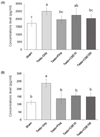Abstract
BACKGROUND/OBJECTIVES
MATERIALS/METHODS
RESULTS
Figures and Tables
 | Fig. 2Effects of corn silk extract on prostate weights.Sham: corn oil + ethanol injection and distilled water oral intake; Testo Only: testosterone injection (10 mg/kg) and distilled water oral intake; Testo+Fina: testosterone injection (10 mg/kg) and finasteride (5 mg/kg) oral intake; Testo+CSE10: testosterone injection (10 mg/kg) and corn silk extract (10 mg/kg) oral intake; Testo+CSE100: testosterone injection (10 mg/kg) and corn silk extract (100 mg/kg) oral intake. Different letters indicate significant differences among group at α = 0.05 as determined by Duncan's multiple range test.
|
 | Fig. 3Hematoxylin-eosin (H&E) staining of prostate.Sham: corn oil + ethanol injection and distilled water oral intake; Testo Only: testosterone injection (10 mg/kg) and distilled water oral intake; Testo+Fina: testosterone injection (10 mg/kg) and finasteride (5 mg/kg) oral intake; Testo+CSE10: testosterone injection (10 mg/kg) and corn silk extract (10 mg/kg) oral intake; Testo+CSE100: testosterone injection (10 mg/kg) and corn silk extract (100 mg/kg) oral intake. (×20)
|
 | Fig. 4Effect of corn silk extract on serum dihydrotestosterone (DHT) concentration.Sham: corn oil + ethanol injection and distilled water oral intake; Testo Only: testosterone injection (10 mg/kg) and distilled water oral intake; Testo+Fina: testosterone injection (10 mg/kg) and finasteride (5 mg/kg) oral intake; Testo+CSE10: testosterone injection (10 mg/kg) and corn silk extract (10 mg/kg) oral intake; Testo+CSE100: testosterone injection (10 mg/kg) and corn silk extract (100 mg/kg) oral intake. Different letters indicate significant differences among group at α = 0.05 as determined by Duncan's multiple range test.
|
 | Fig. 5Effect of corn silk extract on 5α-reductase 2 (5α-R2) concentrations and mRNA expression.Sham: corn oil + ethanol injection and distilled water oral intake; Testo Only: testosterone injection (10 mg/kg) and distilled water oral intake; Testo+Fina: testosterone injection (10 mg/kg) and finasteride (5 mg/kg) oral intake; Testo+CSE10: testosterone injection (10 mg/kg) and corn silk extract (10 mg/kg) oral intake; Testo+CSE100: testosterone injection (10 mg/kg) and corn silk extract (100 mg/kg) oral intake. A: 5α-R2 concentration in prostate in serum, B: 5α-R2 concentration in prostate, C: 5α-R2 mRNA expression in prostate. Different letters indicate significant differences among group at α = 0.05 as determined by Duncan's multiple range test.
|
 | Fig. 6Effect of corn silk extract on prostate-specific antigen (PSA) concentrations in serum and prostate.Sham: corn oil + ethanol injection and distilled water oral intake; Testo Only: testosterone injection (10 mg/kg) and distilled water oral intake; Testo+Fina: testosterone injection (10 mg/kg) and finasteride (5 mg/kg) oral intake; Testo+CSE10: testosterone injection (10 mg/kg) and corn silk extract (10 mg/kg) oral intake; Testo+CSE100: testosterone injection (10 mg/kg) and corn silk extract (100 mg/kg) oral intake. A: serum, B: prostate. Different letters indicate significant differences among group at α = 0.05 as determined by Duncan's multiple range test.
|
 | Fig. 7Effect of corn silk extract on mRNA expression of proliferating cell nuclear antigen (PCNA) in prostate.Sham: corn oil + ethanol injection and distilled water oral intake; Testo Only: testosterone injection (10 mg/kg) and distilled water oral intake; Testo+Fina: testosterone injection (10 mg/kg) and finasteride (5 mg/kg) oral intake; Testo+CSE10: testosterone injection (10 mg/kg) and corn silk extract (10 mg/kg) oral intake; Testo+CSE100: testosterone injection (10 mg/kg) and corn silk extract (100 mg/kg) oral intake. Different letters indicate significant differences among group at α = 0.05 as determined by Duncan's multiple range test.
|
Table 1
Body weights, weight gain, and food efficiency ratio of experimental rats

1)Sham: corn oil + ethanol injection and distilled water oral intake; Testo Only: testosterone injection (10 mg/kg) and distilled water oral intake; Testo+Fina: testosterone injection (10 mg/kg) and finasteride (5 mg/kg) oral intake; Testo+CSE10: testosterone injection (10 mg/kg) and corn silk extract (10 mg/kg) oral intake; Testo+CSE100: testosterone injection (10 mg/kg) and corn silk extract (100 mg/kg) oral intake 2)FER (food efficiency ratio) = Body weight gain (g) /Diet intake (g). 3)Mean ± SD 4)NS: Not significant 5)a>b: Different letters indicate significant differences among group at α = 0.05 as determined by Duncan's multiple range test.
Table 2
Organ weights of experimental rats

1)Sham: corn oil + ethanol injection and distilled water oral intake; Testo Only: testosterone injection (10 mg/kg) and distilled water oral intake; Testo+Fina: testosterone injection (10 mg/kg) and finasteride (5 mg/kg) oral intake; Testo+CSE10: testosterone injection (10 mg/kg) and corn silk extract (10 mg/kg) oral intake; Testo+CSE100: testosterone injection (10 mg/kg) and corn silk extract (100 mg/kg) oral intake
2)Mean ± SD
3)NS: Not significant
Table 3
Activity of aspartate transaminase (AST) and alanine transaminase (ALT) (Karmen/mL)

1)Sham: corn oil + ethanol injection and distilled water oral intake; Testo Only: testosterone injection (10 mg/kg) and distilled water oral intake; Testo+Fina: testosterone injection (10 mg/kg) and finasteride (5 mg/kg) oral intake; Testo+ CSE10: testosterone injection (10 mg/kg) and corn silk extract (10 mg/kg) oral intake; Testo+CSE100: testosterone injection (10 mg/kg) and corn silk extract (100 mg/kg) oral intake
2)Mean ± SD
3)NS: Not significant




 PDF
PDF ePub
ePub Citation
Citation Print
Print



 XML Download
XML Download